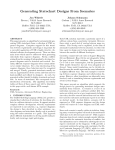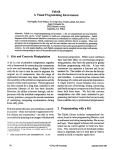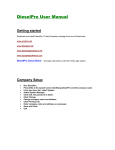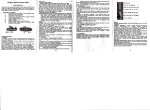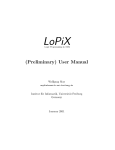Download Generating statechart designs from scenarios
Transcript
Generating Statechart Designs From Scenarios Johann Schumann Jon Whittle Recom / NASA Ames Research Caelum ~ M/S 269-2 Moffett Field, CA 94035 USA +(650) 604-3589 / [email protected] / NASA Ames Research M/S 269-2 Moffett Field, CA 94035 USA +(650) 604-0941 [email protected] . Each UML notation represents a particular aspect of a software system from a particular viewpoint. However, there exists a good deal of overlap between many notations. This overlap can be exploited, in the form of automatic translations between notations, to reduce the time spent in design and to help maintain consistency between the models of different developers. ABSTRACT This paper presents an dgorithm for automatically generating UML statecharts from a collection of UML sequence diagrams. Computer support for this transition between requirements and design is important for a successful application of UML’s highly iterative, distributed software development process. There are three main issues which must be addressed when generating statecharts from sequence diagrams. Firstly, conflicts arising from the merging of independently developed sequence diagrams must be detected and resolved. Secondly, different sequence diagrams often contain identical or similar behaviors. For a true interleaving of the sequence diagrams, these behaviors must be recognized and merged. Finally, generated statecharts usually are only an approximation of the system and thus must be hand-modified and refined by designers. As such, the generated artifact should be highly structured and readable. In terms of statecharts, this corresponds to the introduction of hierarchy. Our algorithm successfully tackles all three of these aspects and will be illustrated in this paper with a well-known ATM example. Currently, commercial tools such as iLogix’s Rhapsody [15] and Rational’s Rose [14] do not adequately bridge the gaps between UML notations. The generation of C++ code is now commonplace, but the generation of UML models themselves has not been adequately addressed. Some model translations can be trivially defined because the models represent the same information in slightly different ways. One such example is converting between sequence diagrams and collaboration diagrams. However, other translations are inherently more involved, such as translating between requirements and actual system designs. This paper presents an algorithm which supports the design process by generating statechaxt designs automatically from scenarios. A scenario is a trace of an individual execution of a (software) artifact [19]. Scenarios are widely used as a (pre-)requirements technique since they describe concrete interactions and are therefore easier for customers and domain experts to use than an abstract model. In what follows, scenarios will be expressed as UML sequence diagrams and the design model will consist of a class diagram and UML statecharts. Keywords UML, Scenarios, Automated Software Engineering 1 INTRODUCTION The Unified Modeling Language (UML) [17] provides a standardized collection of notations for describing artifacts in a software-intensive system. It supports modern complex software development, whereby requirements are expressed in one notation, e.g., sequence diagrams; the design is then described in other notations, e.g., class diagrams and statecharts; finally code is produced using the earlier notations as a guide. This approach allows different stakeholders to develop models independently and encourages rapid prototyping. Since each scenario is usually written in isolation, bringing many scenarios together will result in inconsistencies which have to be detected and resolved1. UML sequence diagrams alone do not contain enough semantic information to enable the automatic detection of conflicts, but this information can be obtained by allowing the user t o express constraints on the diagrams. UML provides a convenient notation for giving such constraints, the Object Constraint Language [17] (OCL), which is a sideeffect free specification language. The OCL constraints Permissio~ito make digital or hard copies of all or part of this work for personal or classrooni use is &ranted without fee provlded that copies are not made or distnbutcd for profit or commercial advantage and that copies bear this notice and the full cltation on the f i n t page Ib COPY othmqse, to republish, to post on serveis or to redlstrlbute to lists, requires pnor specific permission and/or a fee ICSE 2000 Limerick Ireland Copmght ACM 2000 1-58113-206-9/00/6$5 00 ‘This is similar to the feature interactions problem of the telecommunications industry [ll]. 3 14 another one. The generalization relation (+) shows when one class is an instance of another. For further details, see [17]. amount to a very simple domain theory. Domain theories are under-used in software engineering because the effort required to develop a complete and consistent domain theory usually outweighs the gains. In our case, we do not insist on a complete domain theory, but require only a theory expressing instantiations of global variables that can easily be provided by a software engineer. In addition, our approach allows for revisions of the domain theory based on conflicts discovered during statechart generation. This use of a domain theory is a novel one, as traditionally domain theories are considered absolute. The addition of semantic information also allows a justified merging of multiple scenarios. Different scenarios will often contain identical or similar behaviors, and the use of a domain theory allows us to merge these scenarios in a way such that the behavior intended by the user is preserved. €3 cad rmda Since scenarios only give a partial description of a system, we expect the use of this algorithm to be similar to that of a code generator - i.e., the algorithm produces a skeleton design which the user then has to modify/complete. Since the user needs to modify the generated statecharts, they must be readable. This means that the statecharts must include sensible use of hierarchy and orthogonality. We have devised a number of ways of introducing hierarchy into the generated statecharts. We believe that the use of hierarchy is crucial to the success of design generation tools. Figure 1: A Class Diagram for the ATM. e2 lcZl/ (12 Section 2 introduces the relevant parts of the UML along with an example that will be referred to throughout the paper. Section 3 shows how scenarios can be annotated with semantic information and Section 4 presents an algorithm that uses this semantic information to generate statechart designs. Section 5 discusses related approaches and we conclude in Section 6 . Figure 2: Example of a Statechart. 2 UML NOTATION AND EXAMPLE Throughout this paper, we will use an ongoing example to illustrate our techniques. The well-known ATM example (see e.g. [13]) is rather small, yet complex enough to illustrate the main issues. The example describes typical scenarios for user interaction with an ATM machine (e.g., inserting or removing a card, entering a password), and interaction between the ATM, a consortium and the bank for account validation. Statecharts Statecharts, introduced originally by D. Hare1 [6], are finite state machines extended with hierarchy and orthogonality (parallelism), allowing a complex system to be expressed in a more compact and elegant way. Figure 2 shows a simple example of a statechart2. Nodes can either be simple nodes, or composite nodes which themselves contain other statecharts. The initial node in a statechart is marked by 0 . Transitions between states have labels of the form e [ c ] / a . If event e occurs and guard c holds, then the transition may be selected to fire which results in action a being taken and a state change occurring. This behavior is extended in a natural way to handle composite nodes. In Figure 2, if the system is in state B when the transition e [ c ] / afires, Class Diagram A class diagram is a notation for modeling the static structure of a system. It describes the classes in a system and the relationships between them. Figure 1 shows an example of a class diagram for our ATM example. In an object-oriented fashion, the main class (here “ATM toplevel”) is broken down into sub-classes. The aggregation relation (4) shows when one class is part of 2All class-diagrams and statecharts in this paper have been drawn using the Argo/UML tool [2]. 315 - - ATM User Consortium Bank Display main scqen Insert card R e n l , e s t x d - veri account Verify card with balk I I count message Bad account Bad bank account I Verify card with ba k I t I R+password Badpassword H 1 Bad bank password Canceledmessa e I Takecard 4 H Displaymainsc I P=@-l I H Take card t’ n Display mainsc n ,. Figure 4: Interaction with an ATM (SD2). Figure 3: Interaction with an ATM (SD1). then the system changes state to Al. If the system is in any of the states Al,A2,A3 when transition f [ q / b fires, then it will change state to C. other. There are three possible ways to interpret the conjunction of the two SDs - either one or two cards may be inserted; exactly one card must be inserted so SDO is incorrect; or, exactly two cards must be inserted so SD1 is incorrect. In current practice, ambiguities are often resolved by examining the informal documentation but, in some cases, ambiguities may go undetected leading to costly software errors. In the case of computer generation of designs, the documentation is usually too informal for the automatic resolution of conflicts. There are two extreme ways t o overcome this problem. First, insist that the user provides a complete, formal domain theory providing semantic information about the messages. Second, assume no additional semantic information but interpret scenarios based on some heuristic. Neither of these is sufficient, however. The provision of a complete domain theory is overly burdensome and an algorithm with no semantic information ultimately produces incorrect results. By using composite nodes, hierarchy (or depth) can be introduced. This not only decreases the number of individual nodes substantially, but also enhances readability and maintainability of a statechart. For details on statecharts see e.g., [6, 171, for their semantics cf. [7]. Sequence Diagrams The basis for our approach are scenarios which describe concrete examples of the system’s intended behavior. Scenarios can be expressed in UML as sequence diagrams. A sequence diagram (SD) shows the interaction between objects of a system over time. The SD in Figure 3 is an example for interactions between the objects “User”, “ATM , “Consortium” and “Bank”. The vertical lines represent the life-line (or time-line) for the given object, defining the object’s life during the interaction. Messages (like “Insert card”) are exchanged between the objects. In this paper, we will focus on basic SDs; for further details and extensions (e.g., conditional messages, or iteration) cf. [17]. We make a compromise, whereby messages in a sequence diagram may be annotated with a prelpost-condition style specification expressed in OCL. Note that this is only a small additional burden on the user, since the amount of information required by our algorithm for a successful merging of SDs is actually very small. The specifications should include the declaration of global state variables, where a state variable represents some important aspect of the system, e.g., whether or not the user has inserted his card into the ATM. Pre-and post-conditions should then include references to these variables. Note that not every message needs to be given a specification, although, clearly, the more semantic information that is supplied, the better the quality of the 3 ADDING SEMANTIC INFORMATION The simplicity of sequence diagrams makes them suitable for expressing requirements as they can be easily understood by customers, requirements engineers and software developers dike. Unfortunately, the lack of semantic content in sequence diagrams makes them ambiguous and therefore difficult to interpret. For example, suppose there exists an additional sequence diagram, SDO, identical t o SD1 in Figure 3 except that there are two “Insert card” messages adjacent t o each 316 conflicts between the SD and the domain theory (and hence, other SDs). Note that there are two kinds of constraints on a SD: constraints on the state vector given by an OCL specification, and constraints on the ordering of messages given by the SD itself. Conflicts between these constraints mean that either the scenario does not follow the user’s intended semantics or the domain theory is incorrect. The decision as to which holds must be taken by the user and appropriate modifications must be made. This enables both the domain theory and the SDs t o be refined during statechart generation. cardIn, cardHalfuay, passudGiven : Boolean card : Card, passud : Sequence Insert card(c : Card) pre : cardIn = f a l s e post: cardIn = true and card = c Enter password(p : Sequence) pre : passwdGiven = f a l s e and p->f orAll (p->includes (d)=>digit(d)) post: passwdGiven = true and passwd = p Take c a r d 0 pre : cardHalfuay = true post: cardHalfuay = f a l s e and cardIn = f a l s e Display main s c r e e n 0 pre : cardIn = f a l s e and carmalfuay = false post : Request password0 pre : passudGiven = false post: Eject c a r d o pre : cardIn = true post: cardIn = f a l s e and cardHalfway = true and card = n u l l and passwd = n u l l Request take c a r d 0 pre : cardHalfuay = true post: Canceled message0 pre : cardIn = true post: Let a sequence diagram be represented as follows: so m 3 S b , S 1 mz, . . . m,-ts:-l,sp 4 . :s (1) where the mi are messages between objects and si,si are the state vectors immediately before and .after message mi is executed. The source and destination objects of message mi are denoted by maourceand m y e t ,respectively. Si will be used as a notational convenience to denote either si or si. Si[j]is the j t h element of the the vector Si. v j will denote the name of the variable associated with position j in the state vector. Figure 5: Domain Knowledge for the ATM class. The initial state vectors are obtained directly from the message specifications: if mi has a precondition Vj = y, then let sib] := y, and if mi has a postcondition Vj = y, let sib] := y. Otherwise, s i [ j ] = sib] :=?. conflict detection. Currently, our algorithm only exploits constraints of the form VUT = value, but there may be something to be gained from reasoning about other constraints using an automated theorem prover. Since each message is specified independently, the initial state vectors will contain a lot of unknown values. Most (but not all) of these can be given a value in one of two ways. ~ ~~~~ As well as being used for conflict detection, the OCL constraints can be used to identify identical states in different sequence diagrams which allow these diagrams to be merged. The constraints also allow an automatic partitioning of the generated statecharts into hierarchical super-nodes (cf. Section 4). 0 Figure 5 gives specificationsfor selected messages in our ATM example. The state variables, in the form of a state vector, are used to characterize states in the generated statechart. The state vector is a vector of values of the state variables. In our example, the state vector has the form: < cardfn”, cardHalf way-, passwdGiven-, card-, passwd*> where vat-^ E Dom(vur) U {?I,and ? represents an unknown value. The notion of state vector is crucial to our algorithm. 4 GENERATING STATECHARTS Single Sequence Diagrams We shall first consider how individual SDs can be converted into statecharts. This process starts by detecting Unification: two state vectors, Si and Sj (i # j ) , are considered the same if they are unifiable, i.e., there exists a variable assignment $J such that $J(Si)= 4(Sj). This amounts to the detection of loops within a SD. The frame axiom: for each j , if s i b ] =?, i > 0, then let s i b ] := si-l[j] and if sib] = ? then let sib] := sib]. This assumes, of course, that there are no hidden side-effects between messages. These two techniques extend the state vectors by propagating variable values throughout the SD. This allows us to detect conflicts between state vectors - a conflict is detected if the state vector immediately following a message and the state vector immediately preceding the next message differ (if they are unifiable they will already have been unified). Any reported conflicts must be resolved by the user and the algorithm is started again. Figure 6 shows how these techniques fit together. Example. Figure 7 shows SDI from Figure 3 after the state vectors have been extended by unification and the frame axiom. Our procedure detects a conflict with 317 Input. A SD annotated with state vectors Output. A SD with extended annotations for each state vector Si do if there is some j and some unifier I$ with $(Si)= I$(Sj) then unify S i and Sj; propagate instantiations with frame axiom; if there is some IC, Z with si(Z) # s k + l ( Z ) then Report Conflict; break; done <rf.tc.p> <f,jsc,p> ~ Figure 6: Extending the state vector annotations. Figure 7: Figure 3 with Extended Annotations. the domain theory. This arises because state vectors SV1 and SV2 are unified (the figure shows the instantiations of the vectors after unification). This corresponds to the fact that the ATM returns to its initial state after “Take card” is executed. The state vectors tell us that there is a potential loop at this point, which will be created when the SD is translated into a statechart (see Figure 8). The effect of this loop is that there exists an execution path such that the variable passwdCiven is set to true when “Request password” is encountered (the value of passwdCiven is the third element in the vector). However, the domain theory tells us that passwdGiven must be false as a pre-condition of “Request password”. Hence, there is a conflict, which represents the fact that the developer did not account for the loop possibility when designing the domain theory. The user must now decide on a resolution of this conflict - either he can tell the system that the loop is not possible, in which case the unifier that detected the loop is discarded; or he modifies the sequence diagram; or he modifies the domain theory. The action taken in this case is that the domain theory is updated by giving “Eject card” the additional postcondition passwdGiven = false. This extra postcondition resets the value of the variable when the ATM user removes his card. Translation into Finite State Machines Once conflicts have been resolved, we are ready to generate a statechart. Our strategy is to generate a number of flat statecharts (in fact, finite state machines (FSMs)) for each individual SD, one for each object in the SD. Each FSM describes the behavior of the class to which the corresponding object belongs. Messages directed towards a particular object, 0, are considered events in the FSM for 0. Messages directed away from 0 are considered actions. A loop is detected if the state vector immediately after the current message has been executed is the same as an existing state vector and if this message is state-changing, i.e., si # si. Note that some messages may not have been given a specification, hence they will not affect the state vector. To identify states based solely on the state vector will result in incorrect loop detection (e.g., a message with no specification will always loop back to its starting state). To overcome this, loops are only created when the message changes the state. Figure 8 shows how a single SD is translated into a FSM for each object. A FSM, as generated by Figure 8, is a 6-tuple ( N ,SO,V,p, L, 6) where N is the set of nodes, SO E N is the initial node, V is the set of state vectors, p : N + V is a labelling of the nodes with state vectors, L is the set of transition labels and 6 N x L x N is the transition relation. Transition labels are either events, denoted (ev,m), or actions, denoted (ac,m), where m is a sequence of messages. Note that we create a transition for each event and each action. This produces an overly large number of states but makes analysis easier. For presentation to the user, actions and events can be amalgamated into the same transition in the usual statechart style. Our implementation also deals with conditional branches expressed in the sequence diagram which introduce transition guards into the FSM, but we omit these here for the sake of clarity3 . The detection of loops is done in the second if statement in the definition Of ADD. Multiple Sequence Diagrams The previous section dealt with a single sequence diagram. The key ideas were how to identify if a SD conflicts with the domain theory and how to detect loops. When merging multiple sequence diagrams, one way would be to convert each SD to FSMs and then take the union of those FSMs. This is essentially the ap3The semanticsof conditional messages in UML SDs is unclear. We follow that presented in [4] where keywordsIF,ENDIF, CASE, ENDCASE are used to partition a SD into conditional branches. 318 Input. A sequence diagram, S, containing objects 31,. . .,o k and messages ml,. . . ,m, (as in (1)). 3utput. A FSM CO,for each object, 1 5 i 5 IC. messages: Definition 1 Two nodes, n1 and 122 in a FSM, are similar if they have the same state vector, p ( n 1 ) = p ( n 2 ) , and they have at least one incoming transition with the same label, i.e., there exist transitions tl = (n3,1,n1) and t2 = (n4,I , n2) for some nodes n3,n4. br i = 1,...,k do Create a new FSM, CO,, with a single node, n0,i (the initial node) and current node in CO, := no,i; lone br i = 1, ...,r do ADD(^^, ac, myurce); ADD(^^, ev, m y s t ) ; lone where ADD(??ZeSS, type, obj) . curr := current node in c o b j ; if there is a n E Ncobjwith (curr,1, n) E 6 and 1 = (type,mess) and s i = p ( n ) then current node in c&j:= n; return The existence of a common incoming transition means that in both cases, an event has occurred which leaves the state variables in an identical assignment. Hence, the definition takes into account the ordering of the messages and the current state. We illustrate how etransitions are introduced when considering the FSMs generated for an object, 0. Suppose we start with sequence diagrams which are translated into FSMs C l , . . . ,Ck, then we create a new FSM, C, which includes C l , . . . ,c k and has e-transitions as follows: fi if there is a n E Ncosi with si = p ( n ) and mi is state-changing then add new transition (cum,(type,mess),n); current node in c o b j := n; return fi add a new node n and let p ( n ) := si; add a transition (curr,(type,m e s s ) , n); current node in Cobj := n; return 1. Let C be the union of C I ,. . . ,c k , i.e., N c = UiNci , pc = Uipc, etc. 2. Let C have a new initial node no and create Etransitions from no to each of the initial nodes of Cl,...,ck. 3. For each pair of similar nodes, nl and 122 in N c , create +transitions from n1 to n 2 and from n2 to .Figure 8: Translating a sequence diagram into FSMs. 121 The algorithm that we use subsequently is a variant of a standard algorithm for transforming a non-deterministic finite automaton (NFA) into a deterministic finite automaton (DFA) [l]. Each state in the DFA is a set of NFA states which simulates “in parallel” all possible moves the NFA can make on a given input string. In order to leverage off this algorithm, we introduce Etransitions as above. These etransitions are removed by the algorithm resulting in a FSM that has successfully interleaved a number of SDs by placing similar nodes into a single state in the output. proach taken in [18]. Recall, however, that one of our main aims is to generate readable statecharts which can then be further modified by the user. Merely taking the union of the FSMs would result in a chart with many independent branches, one for each SD. Our approach makes an analysis of which nodes in different FSMs can be identified so that different branches can be merged. The result is a statechart with fewer nodes corresponding more closely to the statechart that a designer might produce manually from the SDs. Note that the output of the algorithm is only deterministic in the sense that there are no €-transitions remaining. It still may be the case, however, that there are two transitions leaving a state labelled with the same events but different actions. Hence, our algorithm may produce non-deterministic statecharts. Note that this is a good thing, as a designer may wish to leave a design non-deterministic initially and refine it later. The idea is that we recognize similar nodes from different FSMs and join them with empty etransitions. A standard algorithm from [l] can then be used to remove these etransitions and simultaneously merge similar nodes. A key question then is how to recognize similar nodes. The obvious solution is to define similarity such that two nodes are similar if their state vectors are the same. However, such a definition would produce an excessive number of similar nodes since some messages do not change the state vector. The way around this when merging multiple SDs is to base the notion of similarity on both the state vectors and the ordering of Example. Figure 11 gives the statechart generated automatically from the SDs in Figures 3, 4 , 9 and 10. Our algorithm, implemented in Java, has actually been applied to the full ATM example, which consists of eleven 319 User ATM Consortium Bank ATM User Consortium Bank H Canceled mess e Take card Figure 10: Interaction with an ATM (SD4). Figure 9: Interaction with an ATM (SD3). Figure 11: Statechart generated from SD1,SD2, SD3 and SD4. for introducing hierarchy into the generated FSMs: using implicit information present in the state vectors, introducing generalizations, and using information explicitly given by the user in class diagrams. SDs. Two conflicts were found and a loop was detected which was not intended, but which was allowed by the SDs and domain theory. In this way, the algorithm carries out some degree of validation of the input SDs. Using the State Vector The set of state variables in our annotated SDs provides an excellent means for introducing structure into the generated statechart. State variables usually encode that the system is in a specific mode or state (e.g., if the card is inserted or not). Thus it is natural t o partition the statechart into subcharts containing all nodes belonging to a specific mode of the system. Introducing Hierarchy So far, we have shown how to generate FSMs without any hierarchy. In practice, however, statechart designs tend to get very large and so the judicious use of hierarchy and orthogonality is crucial to readability and maintainability of the designs. In what follows, we consider how hierarchy can be introduced automatically into the FSMs generated by our algorithm. More specifically, we recursively partition the set of nodes according to the different values of the variables in the state vectors. In general, however, there are many different ways of partitioning a statechart, not all of them suited for good readability. Thus, we introduce additional heuristic constraints on the layout of the stat- There are several issues which comprise a “welldesigned” statechart (see, for example, [9]). They include the consolidation of related behavior, the separation of unrelated behavior, and the introduction of meaningful abstractions. We consider three approaches 320 input. A FSM, ( N ,SO, V,p, L, S), S c N , an ordering 4 over the state vector variables, W Output. A partitioning P of the FSM echart. These constraints rule out unreadable partitions and are controlled by user-given parameters: 1. the maximum depth of hierarchy (too many nested levels of compound states limit readability); W‘ := (w1,...,w h ) for wi E W and wi 4 wj,i < j; P := PARTITION(S, W’); while TOPTIMAL(P) do W‘ := select-variableordering(W ); P := PARTITION(& W’); done where PARTITION(S, W’) vj := first(W’); // split on first var. in W’ 2. the maximum number of states on a single level; 3. the maximum percentage of inter-level transitions (transitions between different levels of the hierarchy limit modularity, but can occasionally be useful); 4. a partial ordering, 4,over the state variables, describing an order in which partitions should be at- %(Vj) tempted (some state variables may be more “important” than others and thus should be given priority). The ordering encapsulates important design decisions about the way in which the statechart should be split up. := U {P(4bIh SES m := 12)s(wj)l; for 1 5 i 5 m do sa := {s E SI p(s)[j] = ith(Ds(wj))}; Pi := PARTITION(&, rest(W’)); done P := (PilPi # 0 ) where OPTIMAL(P) check P according t o our design criteria The process of structuring a given subset S of the nodes of a generated FSM is shown in Figure 12. Given the set of variables W of the state vector and the ordering 4 , a sequence W’ is constructed w.r.t. 4. Then the nodes S are partitioned. In case the partition does not meet the design criteria ((1)-(3) above), a warning will be issued that the given ordering would result in a nonoptimal hierarchy and a new ordering of the variables is selected. This selection is done until the criteria are met. Figure 12: Sketch of algorithm for partitioning over the state vector. Example. Figure 13 shows the FSM from Figure 11 which has been partitioned according to the ordering cardIn 4 cardHalfway, and in which the “Cancel” message has been generalized (explicitly by the user) as in the previous paragraph to produce the same behavior for the source state of ‘Request password’ as for the other two states in which it is applicable. The actual splitting is performed recursively according to the variable sequence W‘. Let wj be the top-level variable (minimal in W‘) on which t o split. The partition is made up of m equivalence classes corresponding t o each possible value of wj given in the SDs. For example, for the boolean variable cardIn we would collect all nodes where this variable is true or false, respectively. Then these compound states will be partitioned according t o the remaining variables. Using Class Diagrams It is important t o incorporate other design decisions made by the developer into the synthesis process. Within the UML framework, a natural place for higherlevel design decisions are class diagrams. These describe the types of the objects in the system and the static relationships among them. Generalizations Since SDs often represent concrete instances of a more general behavior, it is useful t o be able t o introduce generalizations into the generated statechart. We present one example of this here. The input SDs show that the event “Cancel” can occur in one of two states (see Figure 11). “Cancel” can be generalized, however, such that it can occur in any state in which cardIn is true and cardHalfway is false. This suggests the introduction of hierarchy by partitioning the statechart over the values of cardIn and cardHalfway, using the ordering cardIn 4 cardsalfway. At present, such generalizations are given explicitly by the user, in the form of expressing an ordering or invoking a transformation, but it may be possible to suggest generalizations automatically, for example, by using machine learning techniques. A hierarchical structure of a generated statechart can easily be obtained from the class diagram: the outermost superstate (surmounting the entire statechart) corresponds t o the class node of the corresponding object. Aggregation results in a grouping of nodes, e.g., in Figure 1, the ATM statechart will have subcharts physical device and dialogs. If a class contains several subclasses (e.g., card-reader and cash-dispenser are sub-classes of physical-device in Figure l),the statecharts corresponding t o the sub-classes are sub-nodes of the current node. Due to space restrictions, we do not show the resulting statechart when Figure 1 is structured according to the class diagram. 32 1 the Biermann-Krishnaswamy algorithm [3]. This algorithm uses backtracking to identify identical states in such a way that the final output FSM will be deterministic. As a result, there is no use of semantic information about the states and the algorithm ultimately may produce incorrect results by identifying two states that are in fact not the same. In addition, designers will often introduce non-determinism into their designs which will only be resolved at a later implementation stage. Hence, the insistence on determinism is overly restrictive. crdln IYcw /old [12] tackles the problem of integration by requiring that the user gives an explicit diagram (a high-level Message Sequence Chart) showing the transitions from one scenario t o the next. This merely shows, however, how the start and end points of different scenarios relate. There is no way to examine the contents of scenarios to, for example, detect interleavings or loops. [SIfollows a similar approach, essentially using an AND/OR tree instead of a high-level Message Sequence Chart. mount mctrqc ;Print rectipt;EJe Figure 13: Structured statechart for the ATM example. The work closest t o our own is described in [16] where timed automata are generated from scenarios. The user must provide message specifications with ADD and DELETE lists which maintain a set of currently valid predicates in a STRIPS-like fashion. States are then identified if the set of valid predicates is the same. The final way of introducing structure is somewhat higher-level than the first two. Typically, the class diagram can be used t o obtain a very abstract structure and the first two methods can be used to introduce further structure within each subchart generated using the class diagrams. 5 RELATED WORK There have been a number of recent attempts at generating specifications from scenarios. Our work stresses The ability t o introduce structure and hierarchy into the generated FSM is crucial if user modifications must be made. [lo] allows the limited introduction of hierarchy if the structure is explicitly represented in the scenarios (e.g., concurrent threads expressed in a collaboration diagram lead t o a statechart node with two the importance of obtaining a specification which can orthogonal subnodes). However, structure beyond that be read, understood and modified by a designer. This is reflected in the following main ways. present in the scenarios must be introduced manually. Our work extends this approach by introducing hierarchy where the structure is deduced from other UML notations, such as a class diagram, or from a domain theory, where partitioning is made over a state variable. Many approaches make no attempt t o interleave different scenarios. [18] gives a learning algorithm for generating a temporal logic specification from a set of examples/counterexamples expressed as scenarios. Each scenario gives rise t o a temporal logic formula Gi and scenario integration is merely Gi augmented with rules for identifying longest common prefixes. In terms of generating FSMs, this corresponds t o having separate branches in the FSM, one for each scenario. However, this does not correspond well t o what a human designer would do. Most other approaches assume the correctness of the input scenarios. In practice, the scenarios will contain ambiguities and inconsistencies. Our algorithm detects conflicts which may correspond to such ambiguities and hence can be used as a guide for refining the scenarios. To further extend our consistency checks, we may be able to leverage off work done in checking the consistency of SCR requirements specifications [8], or work in the feature interactions community [ll]. ui A more effective integration of scenarios necessitates some way of identifying identical states in different scenarios. The solution t o this in [lo] is to ask the user to explicitly name each state in the FSM generated from a scenario. Different states are then merged if they have been given the same name. This approach requires a good deal of effort from the user, however. The SCED tool [13] generates FSMs from traces using 6 CONCLUSIONS We have presented an algorithm for generating UML statecharts from scenarios. These scenarios comprise parts of the system requirements and are given as sequence diagrams. By adding semantic information in the form of a domain theory we are able t o correctly identify similar states and t o detect and report incon- 322 sistencies. By identifying similar states, our approach allows the merging of a number of sequence diagrams into a single statechart. In order t o make such an algorithm practical, the generated statecharts must be readable. To enable this, we introduce structure and hierarchy into the generated statechart. Information and guidance for structuring are taken from the domain theory, a UML class diagram and additional preferences the user may select. A prototype of this algorithm has been implemented in Java. [5] M. Glinz. An integrated formal model of scenarios based on statecharts. In 5th European Software Engineering Conference (ESEC), pages 254-271, Sitges, Spain, 1995. [6] D. Harel. Statecharts: A visual formalism for complex systems. Science of Computer Programming, 8:231-274, 1987. [7] D. Harel, A. Pnueli, J. Schmidt, and R. Sherman. On the formal semantics of statecharts. In Proc. 2nd LICS, pages 54-64. Springer, 1987. The development of high-quality software requires a rigorous enforcement of formal techniques during the entire lifecycle. UML covers a wide spectrum of diagrams and notations on various levels of software development and encourages an iterative life-cycle. For high productivity, a transition between the different levels has t o be made effectively and fast. However, current CASE tools only support translations from specification to code (e.g., generation of C++ code from class diagrams or statecharts). Our approach can be used t o close the gap between the requirements and specification phase. [8] C. Heitmeyer, R. Jeffords, and B. Labaw. Automated consistency checking of requirements specifications. ACM Bansactions on Software Engineering and Methodology, 5(3):231-261, 1996. [9] I. Horrocks. Constructing the User Interface with Statecharts. Addison-Wesley, 1999. [lo] I. Khriss, M. Elkoutbi, and R. Keller. Automating the synthesis of UML statechart diagrams from multiple collaboration diagrams. In UML98: Beyond the Notation, pages 132-147. Springer, 1999. Since most requirements do not specify the full behavior of the system, the generated SCs are only a skeleton which serve as a basis for manual refinement and modification. Therefore, our algorithm fully supports iterative model development. Careful software design requires that the specification and requirements are always kept in a consistent state. Manually maintaining consistency is a tedious and error-prone task. Our algorithm provides the first step towards an automated tool for carrying out such a task. Future plans will augment our algorithms so that changes made t o the generated statechart can be fed back to the sequence diagrams. In this way, design modifications can be validated on-thefly by highlighting scenarios that are no longer valid, or suggesting new scenarios that become possible. [ll] K. Kimbler. Feature Interactions in Telecommunications and Software Systems V. 10s Press, 1998. [12] S. Leue, L. Mehrmann, and M. Rezai. Synthesizing software architecture descriptions from Message Sequence Chart specifications. In Automated Software Engineering, pages 192-195, Honolulu, Hawaii, 1998. [13] T. Miinnisto, T. Systa, and J. Tuomi. SCED report and user manual. Report A-1994-5, Dept of Computer Science, University of Tampere, 1994. [14] Rational Rose. Rational Software Corporation, Cupertino, CA, 1999. REFERENCES [15] Rhapsody. I-Logix Inc., Andover, MA, 1999. A. Aho, R. Sethi, and J. Ullman. Compilers: Principles, Techniques, and Tools. Addison-Wesley, 1986. [16] S. Some and R. Dssouli. From scenarios t o timed automata: building specifications from users requirements. In Asia Pacific Software Engineering Conference, pages 48-57, 1995. Argo/UML. University of California, Irvine, 1999. http://www.ics.uci.edu/pub/arch/uml/index.html. [17] Unified Modeling Language Specification, Version 1.3, 1999. Available from Rational Software Corporation, Cupertino, CA. A. Biermann and R. Krishnaswamy. Constructing programs from example computations. IEEE Transactions on Software Engineering, S E 2(3):141-153,1976. [18] A. van Lamsweerde. Inferring declarative requirements specifications from operational scenarios. IEEE Transactions on Software Engineering, 24(12):1089-1 114,1998. T. Gehrke and T. Firley. Generative sequence diagrams with textual annotations. In Formale Beschreibungstechniken fii'r verteilte Systeme (FBT99), pages 65-72, 1999. [19] K. Weidenhaupt, K. Pohl, M. Jarke, and P. Haumer. Scenarios in system development: Current practice. IEEE Software, pages 3 4 4 5 , 1998. 323










